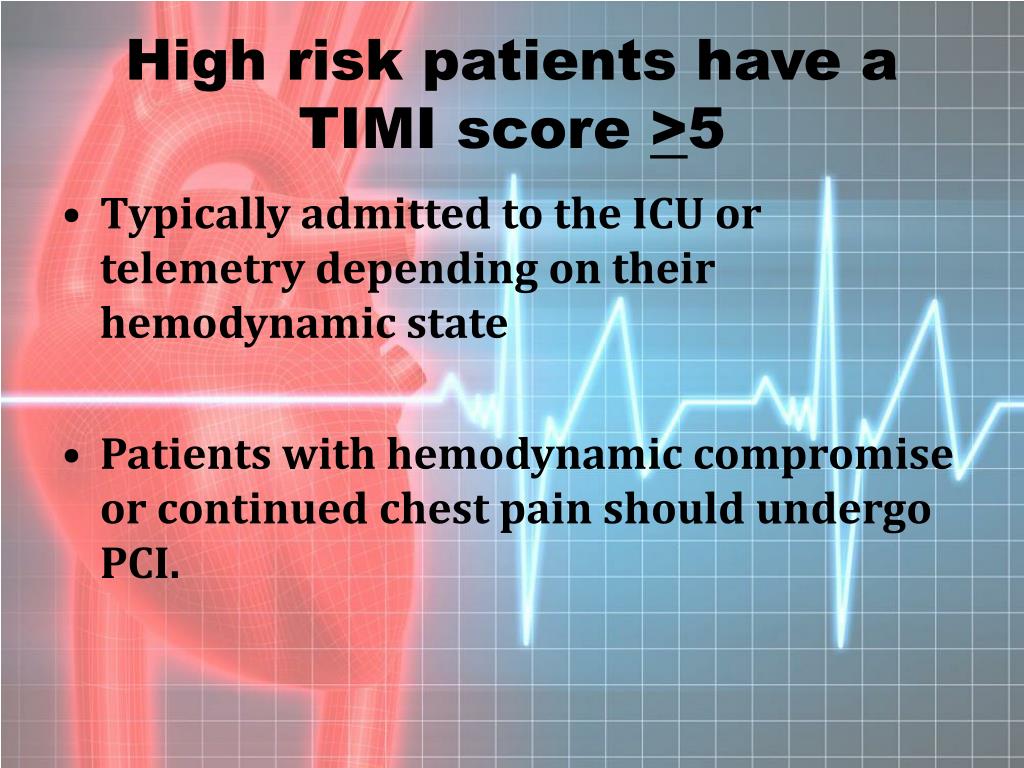

In this study, 158 patients (17.95%) reached a primary end point. The primary end points studied were the same as in the original study. In a retrospective multicenter validation study also by Backus et al (2010), 880 patients presenting with chest pain were evaluated. HEART scores of ≥ 7 points have a risk of 72.7% for any end point and support early invasive strategies. Conversely, HEART scores of 4 to 6 points confer a risk of 20.3% for any end point, implying admission for clinical observation is necessary. HEART scores of 0 to 3 points confer a risk of 2.5% for any end point, and were therefore used to support discharge from the ED. End points in this study were acute myocardial infarction, percutaneous coronary intervention, coronary artery bypass graft, and death. It excluded patients with chest pain and significant ST-segment elevations. The study included any patients admitted to the ED due to chest pain, irrespective of age, prehospital assumptions, and previous medical treatments. The HEART score was originally developed by Backus et al (2008) in a cohort of 122 patients with chest pain in an ED setting. Critical Actionsĭo not use the HEART score if the ECG shows new ST-segment elevation requiring immediate intervention, or with clinically unstable patients. Do not use the HEART score if there is new ST-segment elevation ≥ 1 mm, or if there are other new ECG changes, hypotension, life expectancy < 1 year, or if the clinician identifies noncardiac medical, surgical, or psychiatric illness requiring admission. The HEART score should be used in patients aged ≥ 21 years who present with symptoms suggestive of ACS.

University Hospital, Stony Brook, NY Instructions In the HEART score study, these patients were candidates for early-invasive measures (65.2% in the retrospective study, 50.1% in the prospective study).Ī MACE was defined as all-cause mortality, myocardial infarction, or coronary revascularization.Ībbreviations: ACS, acute coronary syndromes ED, emergency department HEART, history, electrocardiogram, age, risk factors, and troponin MACE, major adverse cardiac event. Scores ≥ 7: 50% to 65% risk of adverse cardiac event.In the HEART score study, these patients were admitted to the hospital (11.6% in the retrospective study, 16.6% in the prospective study). Scores 4 to 6: 12% to 16.6% risk of adverse cardiac event.In the HEART score study, these patients were discharged (0.99% in the retrospective study, 1.7% in the prospective study). Scores 0 to 3: 0.9% to 1.7% risk of adverse cardiac event.The HEART score can be applied to any patient presenting to the ED with chest pain who the physician deems appropriate to evaluate for possible ACS. This helps guide management, leading to better resource utilization, shorter hospital and ED stays for low-risk patients, and earlier interventions for moderate- and high-risk patients. The HEART score objectively risk-stratifies patients into low-, moderate-, and high-risk categories. HEART is most widely validated for regular-sensitivity troponin, although it has been studied recently using high-sensitivity troponin (Ljung 2019). HEART outperforms TIMI, safely identifying more low-risk patients. The HEART score is sometimes compared to the TIMI (Thrombolysis in Myocardial Infarction) and GRACE (Global Registry of Acute Coronary Events) risk scores, which are older ACS scores however, TIMI and GRACE differ from HEART in that they measure risk of death for patients with ACS. The user needs some experience taking a detailed chest pain history and reading ECGs in order to adequately apply these 2 components of the score. MACE is defined as all-cause mortality, myocardial infarction, or coronary revascularization. The HEART score helps identify patients with higher risk of having a major adverse cardiac event (MACE) within the following 6 weeks. It was designed to risk stratify patients with un-differentiated chest pain, not those already diagnosed with acute coronary syndromes (ACS). The HEART score helps emergency department (ED) clinicians risk stratify patients with chest pain into low-, moderate-, and high-risk groups. Each of these is scored with 0, 1, or 2 points. HEART is an acronym of its components: history, electrocardiogram (ECG), age, risk factors, and troponin.


 0 kommentar(er)
0 kommentar(er)
